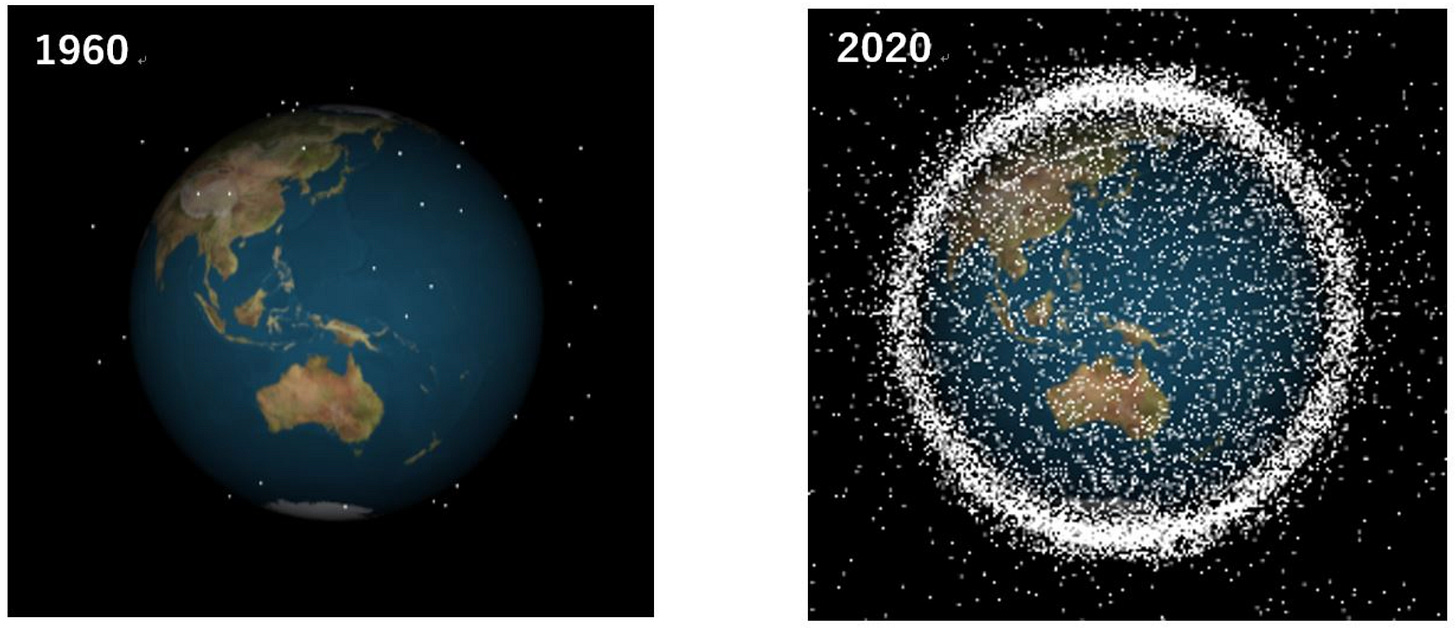Space Debris: Don’t make the same mistake twice
Did you know the International Space Station has had to do 26 maneuvers in the last 20 years to avoid collisions with space debris? Just to avoid the dramatic scenarios shown in the movie “Gravity".
Interest in space operations is booming, thanks to lucrative market opportunities and massive headroom for disruptive technologies. Heightened interest may result in 100,000 satellites deployed in Earth’s orbit by 2030. However, wherever mankind goes so does the waste it produces. The growing number of objects in space increases the likelihood of collisions and generation of space debris, creating a dangerous environment for astronauts and putting future space missions at risk. The danger of space debris derives from its speed. Traveling fast enough to damage or destroy a spacecraft or satellite, space debris can wield destructive power equivalent to a hand grenade. Collisions caused by space debris exacerbate the problem, as each collision creates more debris. For example, in 2009, a US communications satellite and a retired Russian satellite collided, producing thousands of trackable and untrackable fragments, increasing the chance of a 1cm debris striking a space asset to 50% per year. Unless manually removed, space debris can linger in orbit for months, years, or even decades, depending on the altitude. In the worst-case scenario, such a self-sustaining cascade can make certain orbits inaccessible to mankind for many generations. The chain reaction was first explored by a former NASA scientist Don Kessler in 1978, when he came up with a mathematical model that predicted the formation of a belt of debris which could pose a significant threat to our generation. The image below illustrates just how much junk there is in our orbit already.
Fix it before it breaks
In the paper, Kessler proposed the following solution to rising levels of space debris: enhanced spacecraft designs meant to reduce the frequency of structural failures and decrease the number of non-operational satellites. Posterity has incorporated some of Kessler’s proposals. For example, the ISS is designed to withstand objects up to 1cm in size and dodge trackable objects larger than 10cm. The biggest danger comes from objects in between the sizes. The ISS uses Whipple shields that are composed of several thin sheets of armor separated by space. When debris or a meteoroid does strike, it first breaks up into thousands of smaller fragments thereby spreading the energy of the impact over a larger area for the following shield layers. The station’s structure is therefore designed in a way that the probability of any critical component being penetrated by space debris is less than 20% over 10 years.
Earlier this year, the U.S. government published a plan recommending various actions that could mitigate or eliminate the hazards posed by space debris. For example, the government advised implementing hardware and software configurations into the design of launch vehicles, satellites, and space missions that would minimize the generation of space debris in orbit. NASA’s proposed improvements include add-on devices, on-board propulsion for spacecraft maneuverability, improved shielding for better impact resilience, refined payload separation and deployment, debris tracking systems, among others. There are currently no international regulations for the industry, which follows broad guidelines for best practice to mitigate the creation of debris, although it will likely experience an increase in regulatory oversight. Last week, the Federal Communications Commission ruled that satellite operators must de-orbit their assets within 5 years of completing their missions, ending the decade-old 25-year guideline.
Space Debris ‘Cleaning’ Industry is one to watch: laser shooting and spacecrafts with a four-armed claw
The emerging space cleaning industry is forecasted to record more than $14B in revenue over the next decade; the revenue coming from partnerships with satellite operators, launch service providers, and government agencies. The industry encompasses space debris removal, collision avoidance (space situational awareness), and life extension. Notably, space debris removal is projected to be the fastest-growing market at a CAGR of 38%. To remove space junk, some companies work on various approaches that even include shooting debris down with space lasers. EOS, a publicly-traded Australian company, develops ground-based laser systems that can either deflect space debris’ orbital trajectory away from high-value assets or slow the debris, so it ends up in the upper atmosphere and burns up. Although installing space lasers on satellites is probably a more efficient solution, it is generally seen as militarization of space. Instead, many companies are developing technologies that physically remove debris from orbits. For example, ClearSpace uses a rocket-powered spacecraft with a four-armed claw to capture non-operational satellites and other large debris. The company is going to carry out its first mission in 2025. Last year, ClearSpace raised roughly $4M in equity financing to advance its technology which is a nice bonus to the $85M already received from the European Space Agency. Astroscale, a Japan-based startup with $313M in its war chest, develops a magnetic debris capture system that docks to a satellite or space debris. The startup’s technology diverts debris into the upper atmosphere; it also offers inspection and maintenance services. RemoveDebris, a project designed by Airbus and University of Surrey, features a tethered harpoon and net casting system that can be used to capture large pieces of debris.
Space junk tracking: radars, data and monitoring
These efforts are supported by many companies that develop ground-based solutions to track and categorize space debris. For example, MIT-operated Haystack Radar is one of the main sources of spatial data on space junk. Its x-band radar system is directed at selected points in space and waits for debris to pass the radar beam. The collected information about debris size, and direction is then fed into a database that allows space agencies to predict potential collision events. LeoLabs, a late-stage US-based startup, uses ground-based phased array radars to monitor low Earth orbit and track objects as small as 2 cm. The company’s current network includes six radars located in Alaska, Texas, New Zealand, and Costa Rica. Northstar Earth & Space provides commercial space situational awareness and strives to monitor space from space via a constellation of satellites with dedicated optical sensors. Investors have injected more than $80M in the startup since 2015.
Technology isn’t the only aspect of the industry to adapt itself to the growing threat of space debris. Communication and oversight within the industry have also improved. Before every launch, space agencies and private companies must undergo a rigorous risk assessment procedure to determine where and when to launch in order to avoid collisions with already deployed satellites, space debris, or space stations. For example, NASA has entered into an information sharing agreement with Starlink to plan missions and properly program automated avoidance measures. The agreement ensures their assets can take evasive action and prevent collisions when Starlink satellites aren’t able to use collision avoidance, mostly when they are still being activated and put into target orbits.

Space pollution: the new hope
Humans have a terrible track record of dealing with pollution on Earth so far - in the air, oceans, and on land. Now we are adding space into this mix. Challenges will arise, both the expected and the unexpected. Each challenge will demand new technology, and new technology requires further research and increased investments. Some challenges will seem daunting, like the aforementioned veil of space debris hanging in orbit like a gatekeeping specter. Yet, if pessimistic principles were the underlying philosophy of space travel, mankind would never have dared to venture into the New Frontier.










